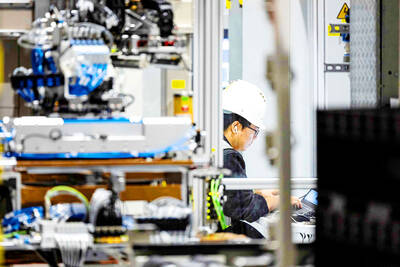Global smartphone shipments are expected to fall 6.5 percent to 1.27 billion units this year, market research firm International Data Corp (IDC) said in a report last week, slashing its June forecast of a 3.5 percent year-on-year fall.
IDC attributed the downward revision to rising inflation, geopolitical tensions and other macroeconomic challenges that have significantly weakened demand, the report said.
While the market researcher views the decline as a short-term setback and expects the market to rebound next year with a 5.2 percent annual increase in terms of shipments, it cut its five-year compound annual growth rate projection to 1.4 percent through 2026, from the previous estimate of 1.9 percent.

Photo courtesy of Samsung Electronics Co
“The supply constraints pulling down on the market since last year have eased and the industry has shifted to a demand-constrained market,” IDC research director Nabila Popal wrote in the report.
However, many smartphone brands have drastically cut back orders for this year amid “high inventory in channels and low demand with no signs of immediate recovery,” Popal wrote.
“The events of the last twelve months have shaved 150 million units off the market for 2022 from our forecast in the second quarter of 2021,” she wrote.
IDC said the slowdown hit emerging markets harder than developed markets, with China likely to see the most significant volume drop of 12.5 percent, or about 41 million units, which amounts to almost half of the overall reduction in global shipments this year.
Shipments in central and eastern Europe are expected to decline 17.4 percent, while those in the Asia-Pacific region excluding Japan and China are predicted to drop 4.5 percent from the previous forecast of 3 percent growth, the report said.
In contrast, shipments in the US are forecast to edge up 0.3 percent and the Canadian market is to see shipments increase 3.2 percent this year, while western Europe would post a 0.7 percent decline, it said.
“Despite the unit decline, average selling prices have grown 10 percent year over year in Q2 and are forecast to grow 6.3 percent for the full year,” Popal wrote.
In the smartphone market, the premium segment has proved resilient to the economic turmoil and has grown 4 percentage points to 16 percent of the overall market and would continue to grow, she said.
The segment refers to smartphones priced at US$800 or more per unit, with foldable devices the fastest-growing segment that would see shipments increase 70 percent year-on-year to 13.5 million units this year, she added.

CHIP RACE: Three years of overbroad export controls drove foreign competitors to pursue their own AI chips, and ‘cost US taxpayers billions of dollars,’ Nvidia said China has figured out the US strategy for allowing it to buy Nvidia Corp’s H200s and is rejecting the artificial intelligence (AI) chip in favor of domestically developed semiconductors, White House AI adviser David Sacks said, citing news reports. US President Donald Trump on Monday said that he would allow shipments of Nvidia’s H200 chips to China, part of an administration effort backed by Sacks to challenge Chinese tech champions such as Huawei Technologies Co (華為) by bringing US competition to their home market. On Friday, Sacks signaled that he was uncertain about whether that approach would work. “They’re rejecting our chips,” Sacks

NATIONAL SECURITY: Intel’s testing of ACM tools despite US government control ‘highlights egregious gaps in US technology protection policies,’ a former official said Chipmaker Intel Corp has tested chipmaking tools this year from a toolmaker with deep roots in China and two overseas units that were targeted by US sanctions, according to two sources with direct knowledge of the matter. Intel, which fended off calls for its CEO’s resignation from US President Donald Trump in August over his alleged ties to China, got the tools from ACM Research Inc, a Fremont, California-based producer of chipmaking equipment. Two of ACM’s units, based in Shanghai and South Korea, were among a number of firms barred last year from receiving US technology over claims they have

It is challenging to build infrastructure in much of Europe. Constrained budgets and polarized politics tend to undermine long-term projects, forcing officials to react to emergencies rather than plan for the future. Not in Austria. Today, the country is to officially open its Koralmbahn tunnel, the 5.9 billion euro (US$6.9 billion) centerpiece of a groundbreaking new railway that will eventually run from Poland’s Baltic coast to the Adriatic Sea, transforming travel within Austria and positioning the Alpine nation at the forefront of logistics in Europe. “It is Austria’s biggest socio-economic experiment in over a century,” said Eric Kirschner, an economist at Graz-based Joanneum

France is developing domestic production of electric vehicle (EV) batteries with an eye on industrial independence, but Asian experts are proving key in launching operations. In the Verkor factory outside the northern city of Dunkirk, which was inaugurated on Thursday, foreign specialists, notably from South Korea and Malaysia, are training the local staff. Verkor is the third battery gigafactory to open in northern France in a region that has become known as “Battery Valley.” At the Automotive Energy Supply Corp (AESC) factory near the city of Douai, where production has been under way for several months, Chinese engineers and technicians supervise French recruits. “They